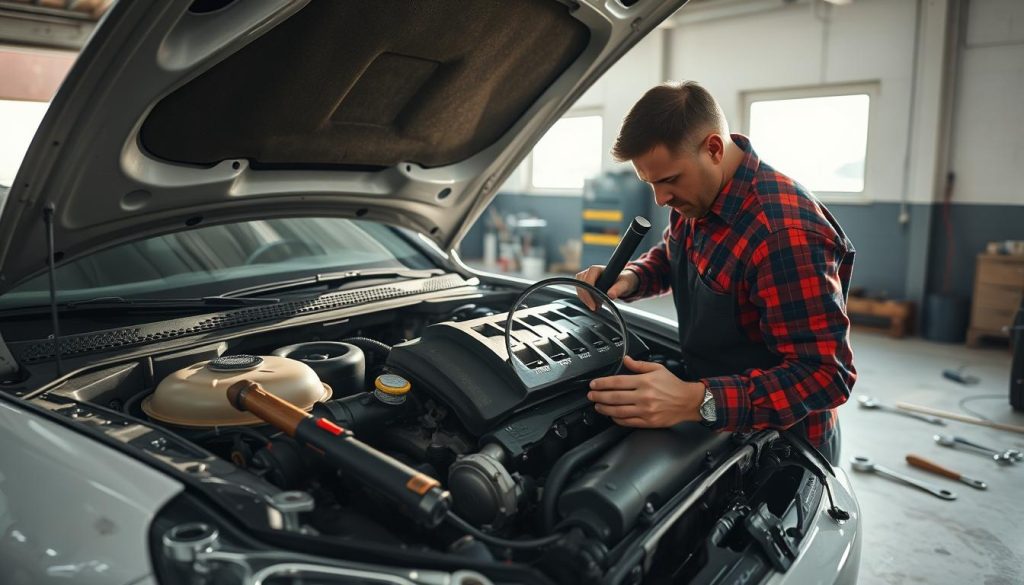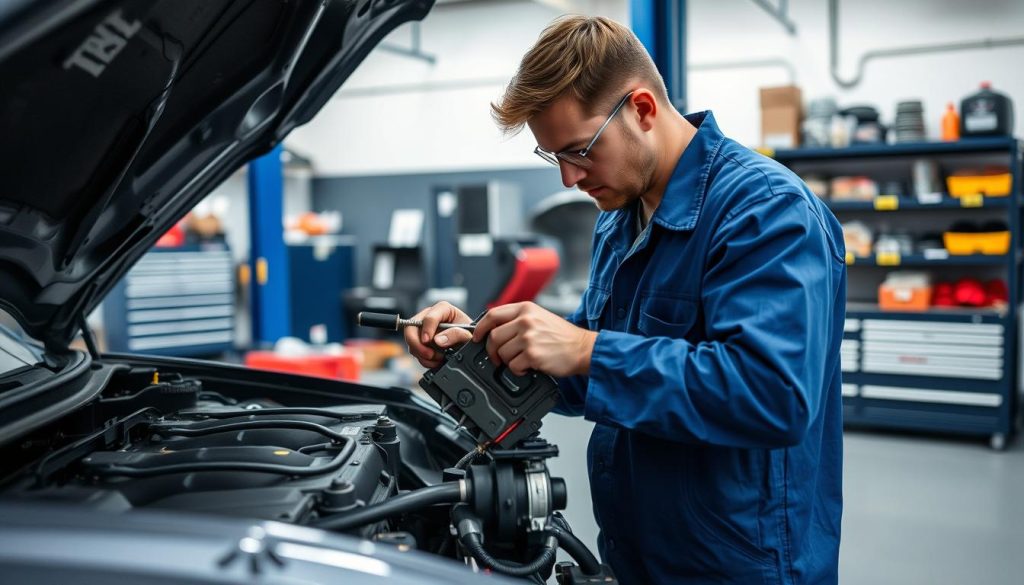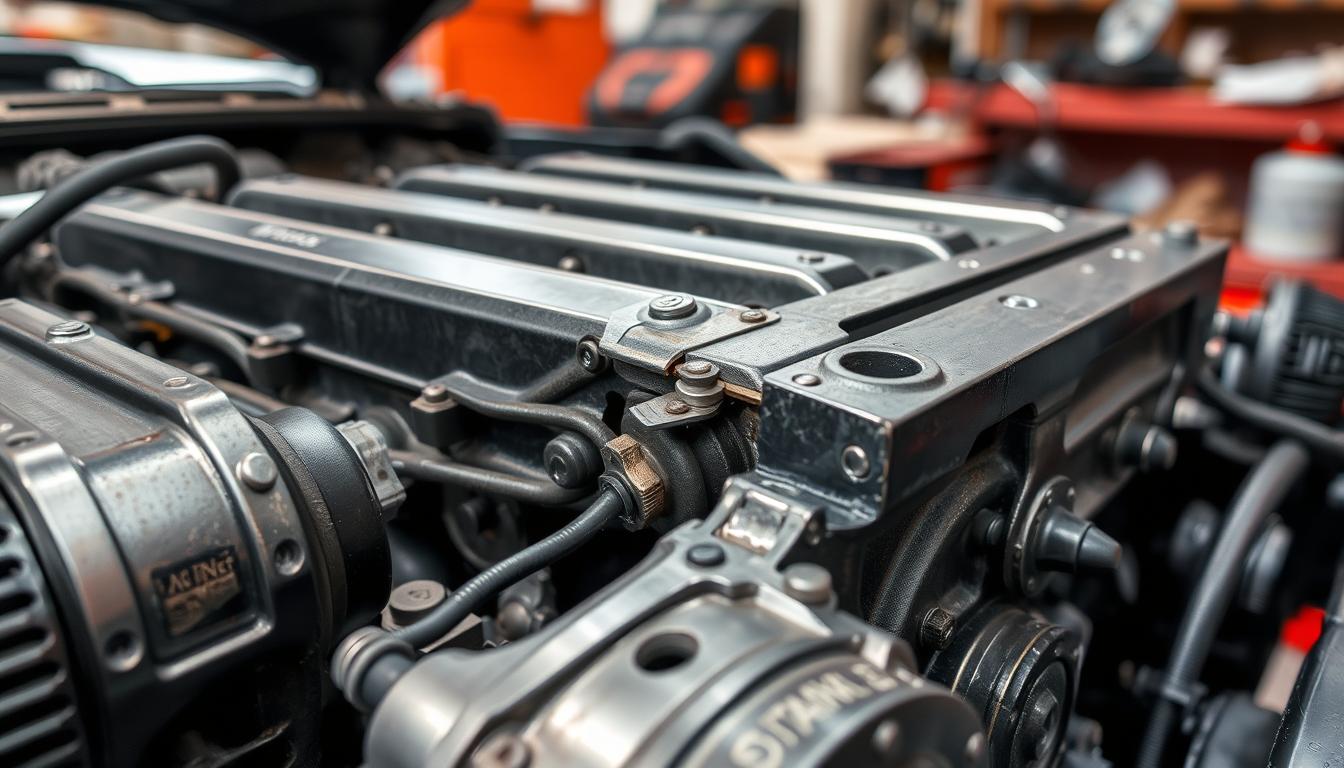As a car enthusiast, I know how vital it is to keep your vehicle’s engine in top shape. A crack in the engine block is a serious issue that can cause big problems if not caught early. In this article, I’ll show you how to spot the signs and symptoms. I’ll also share the best ways to find and fix this problem before it gets worse.
Key Takeaways
- Understand the importance of the engine block and its role in your car’s performance
- Recognize the visual signs of engine block damage, such as fluid leaks and unusual noises
- Learn about professional diagnostic tools and DIY methods for crack detection
- Discover preventative maintenance tips to avoid engine block issues
- Know when to seek professional help and consider the cost implications of repairs
Understanding Engine Block Basics and Their Importance
The engine block is the heart of a car’s engine. It holds the engine’s key parts. The materials used, like cast iron and aluminum, greatly affect how well the engine works and lasts.
Common Materials Used in Engine Block Construction
For a long time, cast iron was the top choice for engine blocks. But now, aluminum alloys are becoming more popular. Each material has its own benefits:
- Cast iron engine blocks are strong, rigid, and keep heat well. They’re great for high-performance cars.
- Aluminum engine blocks are lighter. This helps cars use less fuel and handle better.
The Role of Engine Blocks in Vehicle Performance
The engine block is the base of the engine. It affects how well a car performs. Its design and materials impact power, efficiency, and reliability. This shapes the driving experience.
Why Engine Block Integrity Matters
Keeping the engine block in good shape is key. Any damage can harm the engine’s strength and cause big problems. Fixing engine block issues quickly is vital for a car to run well.
Visual Signs of Engine Block Damage
As a car enthusiast, I know spotting engine block damage can be tough. But it’s key to catch problems early. A good way to find issues is by doing a visual check. Let’s look at the main signs that show visible engine cracks, external engine damage, or coolant leaks.
Start by looking at the engine block’s outside for cracks or warping. Visible engine cracks can signal bigger problems inside. These cracks often show up on the block’s surface, near high-stress areas or cylinder walls.
Another sign of external engine damage is oil or coolant leaks. Look for any stains or fluid buildup around the engine. This could mean a leak in the engine’s seals or gaskets. Check the oil pan, cylinder head, and water pump areas for coolant leaks.
| Visible Sign | Potential Issue |
|---|---|
| Cracks on the engine block surface | Visible engine cracks |
| Discoloration or fluid buildup around the engine | External engine damage or coolant leaks |
By watching for these signs, you can spot engine block problems early. This way, you can fix them before they get worse. Remember, regular checks and care are vital for your car’s health and performance.
Common Symptoms of a Cracked Engine Block
A cracked engine block can show itself in many ways. It can cause fluid leaks or affect how the engine runs. Knowing these signs is key to fixing the problem quickly.
External Fluid Leaks and Their Locations
Fluid leaks are a clear sign of a cracked engine block. These leaks happen around the engine block. They let engine oil or coolant escape.
Drivers might see puddles of engine oil leaks or coolant loss under the car. These puddles are usually near the oil pan or water pump.
Performance Issues and Warning Signs
A cracked engine block can also change how the engine performs. Drivers might notice the engine doesn’t run as well. This can include losing power, having trouble accelerating, or engine misfires.
These problems happen because the crack affects the engine’s inner workings. It makes the engine less efficient.
Strange Noises and Vibrations
A cracked engine block can also make strange sounds and vibrations. Drivers might hear knocking, tapping, or grinding noises. These sounds come from inside the engine.
Excessive vibrations are another sign of a problem. They show the engine block is not working right.
Knowing these symptoms can help drivers catch engine block issues early. This allows for quick fixes before things get worse.
“Addressing engine block cracks promptly is key. It prevents more damage and keeps your car running well.”
Car Engine Diagnostic Methods for Crack Detection
Finding a crack in the engine block can be tough. But, there are many ways to spot the problem. As a skilled auto tech, I mix different methods for the best results.
I start with an OBD-II scanner. It connects to the car’s computer and shows error codes. This helps me find the cause of a cracked engine block.
- Next, I do a compression test. It measures each cylinder’s pressure. Low pressure can mean a crack or damage.
- Then, I run a leak-down test. It finds air leaks, which could be from a cracked engine block.
Using these engine diagnostics tools helps me find and fix a cracked engine block. This way, repairs are more precise and effective.
“Proper engine diagnostics are key to identifying and addressing any underlying issues before they become major problems.”
Knowing how to use car engine diagnostic methods is vital. It helps me find and fix a cracked engine block. By keeping up with new tech and methods, I ensure my customers’ cars run smoothly.
Professional Testing Tools and Equipment
As a professional mechanic, I use many tools to find engine block cracks. These tools are more advanced than DIY methods. They help keep your vehicle’s engine safe and sound.
Pressure Testing Equipment
A coolant pressure tester is key for finding engine block cracks. It puts pressure on the coolant system. This lets me find leaks or weaknesses in the engine block.
By watching the pressure, I can spot even small cracks. This means I can fix them quickly and well.
UV Dye Testing Methods
I also use a UV dye leak detection system. It adds a special dye to the coolant system. This dye glows under UV light, showing where leaks or cracks are.
This makes it easy for me to find the problem. Then, I can plan the right fix for it.
Advanced Scanning Technologies
For a detailed check, I might use thermal imaging cameras. These cameras spot tiny temperature changes in the engine block. This can mean there’s a crack or other issue.
With these tools and my experience, I can give you a precise diagnosis. This ensures your engine runs smoothly and safely.
My professional tools and equipment let me find and fix engine block cracks with great accuracy. These advanced tools help keep your engine healthy. This keeps you safe and saves you money in the long run.
DIY Methods to Check for Engine Block Cracks
As a car enthusiast, I know how vital it is to watch your engine’s health. While getting a professional check is key, there are DIY ways to spot engine block cracks at home. Let’s look at these simple yet effective methods.
Visual Crack Detection
One simple way to check your engine block for cracks is by looking closely. Start by carefully inspecting the engine block for any visible damage. Look for cracks, discoloration, or unusual wear and tear. The areas around the coolant passages are common spots for damage.
Coolant Level Monitoring
Watching your engine’s coolant level can also give you clues about its condition. If you see a sudden or unexplained drop in coolant level, it might mean there’s a crack or leak. Always check your coolant levels and add more as needed.
Exhaust and Oil Inspection
Another DIY way to find engine block cracks is by checking the engine’s exhaust and oil. Look for unusual discoloration or excessive white smoke in the exhaust, which could indicate a crack that’s allowing coolant to mix with the combustion process. Also, check the engine oil for coolant contamination, a sign of a cracked engine block.
While these DIY methods can spot issues, it’s best to have a pro check your engine block thoroughly. Regular maintenance and quick repairs can help keep your engine running longer.

“Proactive maintenance and vigilance are key to catching engine block issues early on, before they turn into costly repairs.”
Prevention Tips and Regular Maintenance
Keeping your engine in top shape is key to avoiding expensive repairs later. Regular maintenance and preventive steps can help your engine last longer. This means fewer chances of cracks or damage. By being proactive, you can protect your engine and enjoy a better driving experience.
Routine Inspection Schedule
Regularly checking your engine block is a must for your car’s upkeep. This includes:
- Checking the coolant level and condition every 6 months or 5,000 miles
- Inspecting the engine block for any visible cracks or damage during oil changes
- Performing a complete engine diagnostic test annually or when problems occur
Proper Engine Care Guidelines
Good engine care can prevent overheating and other problems that might cause cracks. Here are some important tips:
- Keep the coolant level right and change it as the maker suggests
- Avoid long engine idling or heavy loads for too long
- Fix any coolant leaks or engine issues right away
- Make sure the cooling system works well and replace old or damaged parts
By sticking to a regular maintenance schedule and caring for your engine well, you can lower the risk of engine block cracks. These steps will protect your investment and keep your car running smoothly for a long time.
| Maintenance Task | Recommended Frequency |
|---|---|
| Check coolant level | Every 6 months or 5,000 miles |
| Inspect engine block for cracks | During oil changes |
| Perform engine diagnostic test | Annually or as needed |
When to Seek Professional Help
As a car lover, you might want to fix engine problems yourself. But, diagnosing and repairing a cracked engine block needs a professional mechanic. Trying to do it yourself can cause more harm and cost a lot.
While you can do some basic car care at home, fixing a cracked engine block is too hard. It’s best to get help from a dealership service center or a skilled independent mechanic. They have the right tools and knowledge to fix your engine right.
Signs You Need Professional Assistance
- Persistent engine oil or coolant leaks
- Noticeable performance issues, such as loss of power or misfiring
- Unusual engine noises or vibrations
- Failure to locate the source of the problem after attempting basic troubleshooting
If you see any of these signs, it’s time to get a professional mechanic. They can check your engine and find the best solution. Ignoring a cracked engine block can cause more damage and even need a new engine. So, it’s safer to get expert help.
Choosing the Right Service Provider
Choosing between a dealership service center and an independent professional mechanic has its pros and cons. Dealerships have the latest tools and know-how, but might cost more. Independent mechanics offer personal service and could be cheaper, but might not know as much.
The right choice depends on your needs, the problem’s severity, and who you trust. Look up local options, read reviews, and think about warranty, parts, and experience with your car’s make and model.

When dealing with a cracked engine block, it’s wise to get a professional mechanic or a dealership service center. Ignoring this problem can lead to bigger issues and more expensive fixes later.
Cost Implications of Engine Block Repairs
Engine block repairs can cost a lot, depending on the problem and the car. Minor issues might cost a few hundred dollars. But, serious problems could lead to a engine replacement costing thousands. Knowing the costs and your options is key to making the right choice.
Repair vs. Replacement Options
Minor cracks or damage might be fixable. This could involve welding or replacing parts. But, if the damage is too much, you might need a new engine. This is usually more expensive, with costs ranging from a few thousand to tens of thousands of dollars.
Insurance Coverage Considerations
Auto insurance might help with the costs of repairs or a new engine. If you have a policy that covers sudden damage, you could be in luck. Always check your policy to see what’s covered.
“Investing in regular engine maintenance can help prevent costly engine block repairs down the line.”
Engine repairs or replacements can be very expensive. But, knowing your insurance and options can help. Regular maintenance can also prevent big problems and keep your car running longer.
Conclusion
Understanding engine block cracks is key to keeping your car running well. Knowing the signs of damage and doing regular checks can help. This way, you can keep your car’s engine in good shape for longer.
Regular checks and quick action to problems are very important. Finding cracks early can save you from expensive fixes. A well-kept engine block means your car will run smoothly for many years.
Looking after your car’s engine is a smart move. It keeps you calm and makes your car last longer. With the right knowledge and help, you can handle any engine issues. This keeps your car in great shape and lets you enjoy driving for a long time.

Leave a Reply